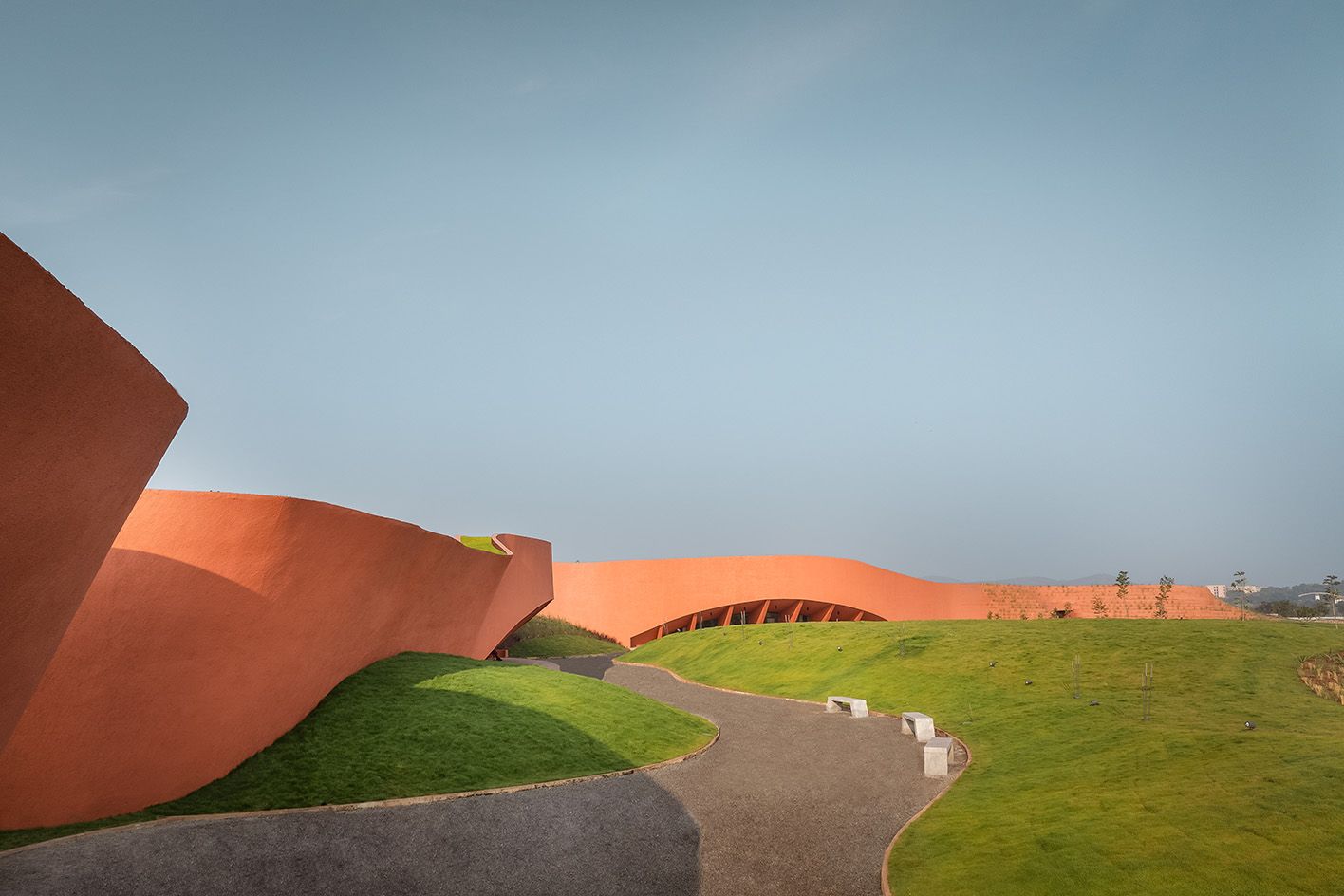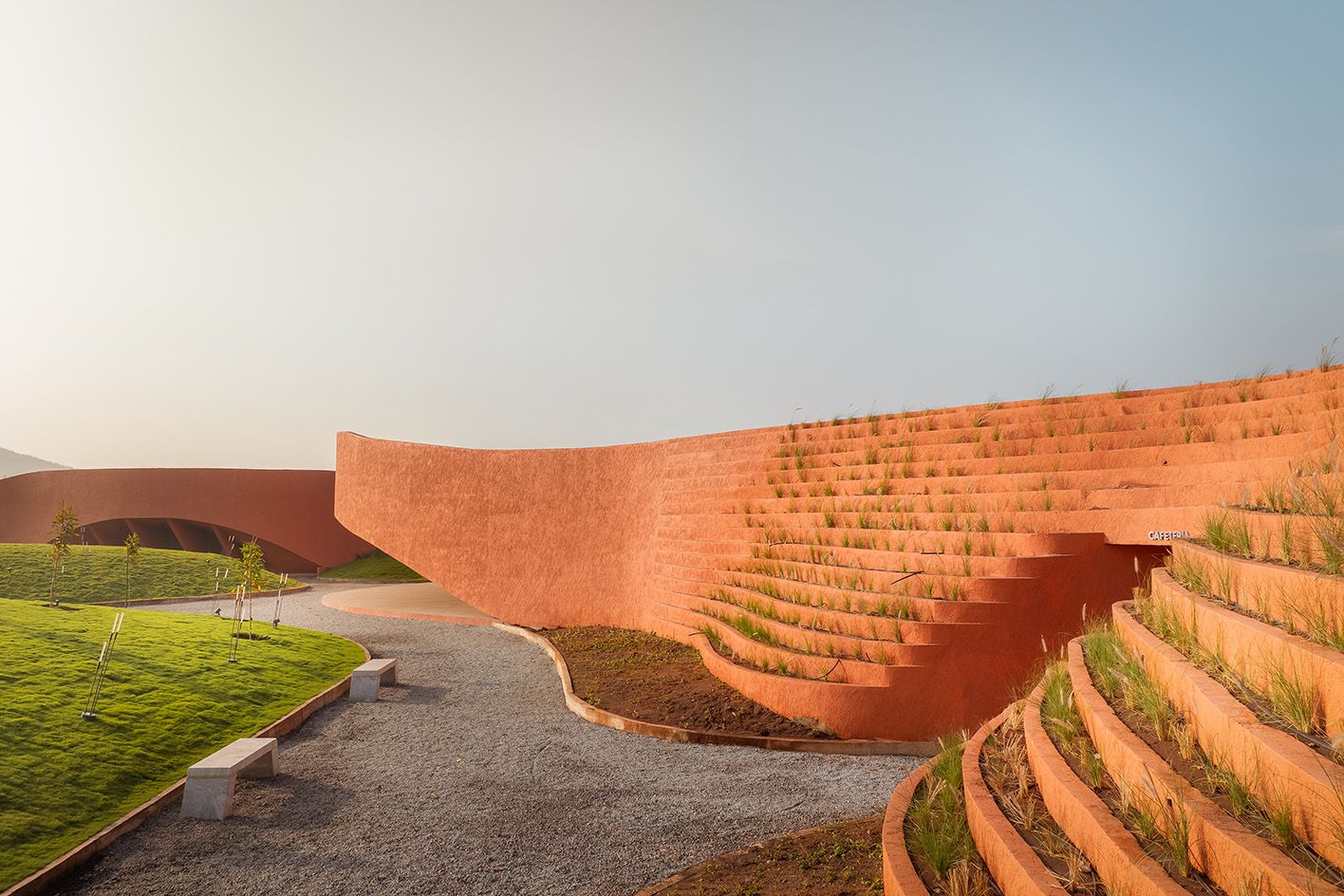India’s Hampi Art Labs is a piece of architecture at one with its content and context
The world-class Hampi Art Labs by Indian architect Sameep Padora, near South India’s Hampi Unesco World Heritage Site, mimics the contours of the nearby Tungabhadra River

When viewed from a distance, Hampi Art Labs could pass for a spectacular riverbank – if a riverbank did such a thing as levitate. Located in southern India near the Unesco World Heritage Site of Hampi, the structure is a sleight of hand by leading Indian architect Sameep Padora (behind numerous Indian houses, such as Lattice House, as well as Wallpaper* Design Awards Best Public Building 2021 Temple of Steps).
Hampi Art Labs undulates with the landscape, echoing the nearby Tungabhadra River and exuding a lightness of being that belies its sculptural proportions. Spread across 18 acres of virgin land, the recently opened arts centre, founded by Sangita Jindal and Tarini Jindal Handa of Indian powerhouse JSW, plays host to exhibition spaces, studios, ceramic and printmaking workshops, gardens, apartments for residencies, and a café.

Hampi Art Labs: a modern building for a storied site
For Padora, the founder and principal of his eponymous Mumbai-based practice, it was important to tread lightly. After all, the city has a storied past. Between the 14th and early 17th centuries, the land today known as Hampi was the roaring capital of the Vijayanagara empire, the last great Hindu kingdom. Its rulers built forts, royal complexes, temples, pillared concourses, memorial structures and waterways, ensuring an architectural legacy that would outlive their reign.
The effort proved fruitful even in the face of invasion, when many structures were ravaged beyond redemption. The ones that survived sit shoulder to shoulder today with the ragged hills and thousands of naturally occurring granite boulders for which Hampi is equally famed.

For a land so exceptional, the architecture had to be equally so, although Padora admits that the point of departure wasn't immediately clear. ‘We deliberated over whether to reference the historic architecture or the barren landscape it sat on, and ultimately decided on the latter. It was important to contextualise the new build to what had endured over the centuries, not what hadn't,’ says Padora.

Nodding to the natural context, each space was designed to hold a mirror to the topography. A case in point is the edifice housing the gallery and studios. Shaped like a meandering river, it echoes the ebb and flow of the activity around. In determining its curvature, Padora took a leaf from urban sociologist Manuel Castells’s ‘space of flows’ concept. ‘The term, in this case, encapsulates all manner of natural occurrences: gravity, percolation, mountainous desire paths. I imagined the people inside in much the same way. The idea was to let them get swept deeper and deeper,’ he says.

Padora envisaged the landscape not as a backdrop for art, but as a work of art itself. This meant treating the roof no differently from the ground, even merging the two with steps that challenge where, or whether, one ends and the other begins. Likewise, the entire exterior, including the roof, is characterised by locally sourced terracotta, and the rooftop walking path is flanked by garden beds that will, in time, grow to cover the hardscape and camouflage it against the surrounding verdure.

Padora and his team – which included architects Aparna Dhareshwar, Vami Koticha, Kunal Sharma and Aum Gohil – took a similar approach with the artist residences, imagining them as pebbles in a stream amidst courtyards emblematic of water. Each residence is outfitted with a kitchenette, a dining room, a walk-in closet and bathroom, and a living room with a megalithic granite sofa that seemingly grows out of the ground. ‘We exercised both a local sensitivity and a global sensitivity, with native materials variously reimagined in modern forms,’ says Handa, Hampi Art Labs’ creative director.

Padora’s ethos of fluidity went hand in hand with Handa’s, who was firm in her belief that Hampi Art Labs’ world-class residency programme should be open to anyone from anywhere, and indeed it welcomes artists from across the globe. Its inaugural cycle includes Bhasha Chakrabarti of the United States, Promiti Hossain of Bangladesh, and Sharbendu De, Madhavi Gore and Anirudh Singh Shaktawat of India.

Hampi Art Labs’ maiden exhibition, 'Right Foot First', curated by independent curator Phalguni Guliani, is of special note. Borrowing works from the prized Jindal Collection, it presents ensembles of artworks that at once contrast and complement each other, transcending various disciplines, generations and eras. Featured artists include Andy Warhol, Atul Dodiya, Annie Morris, Atul Dodiya, Ai Weiwei, Bharti Kher, BV Doshi, Dayanita Singh, Lubna Chowdhary, Manish Nai, Manu Parekh, Praneet Soi, Reena Saini Kallat, Rohini Devasher, Sayan Chanda, Sheba Chhacchi, Shilpa Gupta, Suhasini Kejriwal, Tushar Joag and Zarina Hashmi.

The current exhibition is designed to echo the overarching architecture by way of curvilinear walkways that represent the philosophical idea that ‘no man can ever step in the same river twice’. It is a metaphor perfectly apt for an arts centre ever evolving, and one expected to be ever in spate.

Hampi Art Labs opens on 6 February 2024 Hampi, India
Wallpaper* Newsletter
Receive our daily digest of inspiration, escapism and design stories from around the world direct to your inbox
-
 A new era for Iittala: inside the Finnish company's rebrand
A new era for Iittala: inside the Finnish company's rebrandIittala hails a new era, led by creative director Janni Vepsäläinen, and marked by a new logo and collections that pay homage to Aino and Alvar Aalto's heritage
By Emma O'Kelly Published
-
 Loewe’s latest candles evoke scents of mushrooms and roasted hazelnuts
Loewe’s latest candles evoke scents of mushrooms and roasted hazelnutsThe Loewe ’Mushroom’ and ‘Roasted Hazelnut’ candles are new additions to the house’s wider range of fruit and vegetable-based home scents
By Hannah Tindle Published
-
 Moncler reaches new heights with blockbuster Grenoble show on the slopes of St Moritz
Moncler reaches new heights with blockbuster Grenoble show on the slopes of St MoritzWallpaper* heads to the snowy peaks of St Moritz for a Moncler Grenoble show which asserted the outerwear behemoth’s dominance over the slopes – with a fittingly star-studded guest list to match
By Jack Moss Published
-
 House of Greens in India’s Bengaluru is defined by its cascading foliage
House of Greens in India’s Bengaluru is defined by its cascading foliageNestled in Bengaluru’s suburbs, House of Greens by 4site Architects encourages biophilic architecture by creating a pleasantly leafy urban jungle
By Tianna Williams Published
-
 Surajkund Craft’s Northeast Pavilion in India is an exemplar in bamboo building
Surajkund Craft’s Northeast Pavilion in India is an exemplar in bamboo buildingThe Northeast Pavilion at the Surajkund Craft Fair 2023, designed by atArchitecture, wins Best Use of Bamboo in the Wallpaper* Design Awards 2024
By Ellie Stathaki Published
-
 OpenIdeas has designed Link House, an expansive Gujarat family complex
OpenIdeas has designed Link House, an expansive Gujarat family complexLink House accommodates two households in high modern style in the Indian state of Gujarat, innovatively planned around the requirements of a large extended family
By Jonathan Bell Published
-
 This Chandigarh home is a meditative sanctuary for multigenerational living
This Chandigarh home is a meditative sanctuary for multigenerational livingResidence 91, by Charged Voids is a Chandigarh home built to maintain the tradition of close family ties
By Tianna Williams Published
-
 Studio Mumbai exhibition at Fondation Cartier explores craft, architecture and ‘making space’
Studio Mumbai exhibition at Fondation Cartier explores craft, architecture and ‘making space’A Studio Mumbai exhibition at Paris’ Fondation Cartier explores the trailblazing Indian practice’s inspired, hands-on approach
By Amy Serafin Published
-
 Debris Block House in India’s Bengaluru nestles into its leafy landscape
Debris Block House in India’s Bengaluru nestles into its leafy landscapeDebris Block House by Collective Project intertwines contemporary architecture, flora and roof gardens, as it nestles within its native landscape
By Tianna Williams Published
-
 Misa Architects, India: Wallpaper* Architects’ Directory 2023
Misa Architects, India: Wallpaper* Architects’ Directory 2023Misa Architects from Ahmedabad, India, joins the Wallpaper* Architects’ Directory 2023, our annual round-up of exciting emerging architecture studios
By Nana Ama Owusu-Ansah Published
-
 Kempegowda International Airport’s Terminal 2 is a celebration of its ‘garden city’, Bengaluru
Kempegowda International Airport’s Terminal 2 is a celebration of its ‘garden city’, BengaluruKempegowda International Airport in India gets a new terminal by SOM, prioritising sustainability and wellbeing
By Ellie Stathaki Published










